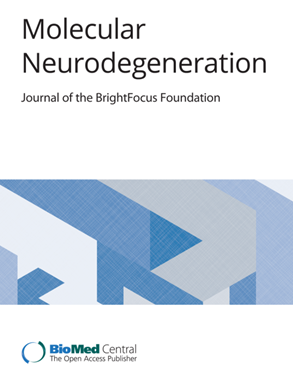pkc1 -β-arrestin2轴破坏SORLA逆行运输,驱动其降解和阿尔茨海默病中的淀粉样蛋白病理。
IF 17.5
1区 医学
Q1 NEUROSCIENCES
引用次数: 0
摘要
背景SORL1变异与晚发性和早发性阿尔茨海默病(AD)相关。SORL1编码带有A repeat的分选相关受体(SORLA)蛋白,属于VPS10受体家族。SORLA通过其分选功能防止AD发病,并且在散发性AD中一直观察到SORLA水平降低。尽管SORLA在阿尔茨海默病发病机制中的重要性已得到充分认识,但由于对其通过细胞内信号传导调节的认识不足,如何靶向治疗阿尔茨海默病仍有待确定。方法采用生物化学、细胞生物学和药理学相结合的方法,研究SORLA的转运和稳定性是如何受到调控的。此外,我们使用AD小鼠模型、死后组织样本和ipsc衍生的神经元来检查这种调节的功能结果。结果我们发现了SORLA与β-阻滞蛋白2 (βARR2)之间的一种新的直接相互作用,这种相互作用阻碍了SORLA与逆行复合物的相互作用,从而减少了SORLA的逆行贩运。βARR2促进SORLA与ESCRT0复合物之间的相互作用,导致SORLA的溶酶体定位和降解。我们还发现PKCι/λ诱导SORLA磷酸化,并增强其与βARR2的相互作用,促进SORLA降解。重要的是,在AppNL-G-F/NL-G-F AD小鼠模型中,用金酰胺阻断PKCι/λ破坏SORLA-βARR2相互作用,提高SORLA水平,降低APP的淀粉样变性加工,并改善认知。此外,PKCι在人类AD大脑中过度活跃,金糠蛋白通过增加SORLA水平减少AD ipsc衍生神经元中Aβ的产生。我们的研究揭示了PKCι/λ-βARR2轴是破坏SORLA逆行运输并驱动其降解的关键分子机制。我们的研究结果首次证明SORLA水平可以通过阻断PKCι/λ来减少Aβ的产生并缓解ad相关表型。值得注意的是,重新利用经fda批准的类风湿性关节炎药物金糠蛋白,可能为阿尔茨海默病的治疗提供潜力。本文章由计算机程序翻译,如有差异,请以英文原文为准。
The PKCι-β-arrestin2 axis disrupts SORLA retrograde trafficking, driving its degradation and amyloid pathology in Alzheimer's disease.
BACKGROUND
Variants of SORL1 have been associated with both late and early onset of Alzheimer's disease (AD). SORL1 encodes the sorting-related receptor with A repeat (SORLA) protein, which belongs to the VPS10 receptor family. SORLA protects against AD pathogenesis through its sorting function, and reduced SORLA levels have been consistently observed in sporadic AD. Although the importance of SORLA in AD pathogenesis is well recognized, how it can be targeted for AD treatment remains to be established, owing to the inadequate understanding of its regulation by intracellular signaling.
METHODS
We employed combined biochemical, cell biological, and pharmacological approaches to investigate how SORLA trafficking and stability are regulated. Additionally, we used an AD mouse model, postmortem tissue samples, and iPSC-derived neurons to examine the functional outcomes of this regulation.
RESULTS
We identified a novel direct interaction between SORLA and β-arrestin2 (βARR2), which impedes the interaction of SORLA with the retromer complex, thus reducing the retrograde trafficking of SORLA. βARR2 promotes the interaction between SORLA and the ESCRT0 complex, leading to the lysosomal localization and degradation of SORLA. We also found that PKCι/λ induces SORLA phosphorylation and enhances its interaction with βARR2, promoting SORLA degradation. Importantly, blocking PKCι/λ with auranofin disrupts the SORLA-βARR2 interaction, elevates SORLA levels, decreases amyloidogenic processing of APP, and improves cognition in the AppNL-G-F/NL-G-F AD mouse model. Furthermore, PKCι is hyperactive in human AD brains, and auranofin reduces Aβ production in AD iPSC-derived neurons through increasing SORLA levels.
CONCLUSION
Our study reveals the PKCι/λ-βARR2 axis as a key molecular mechanism that disrupts SORLA retrograde trafficking and drives its degradation. Our findings represent the first evidence that SORLA levels can be pharmacologically manipulated through blocking PKCι/λ to reduce Aβ production and alleviate AD-related phenotypes. Notably, repurposing auranofin, an FDA-approved drug for rheumatoid arthritis, may offer the potential for AD treatment.
求助全文
通过发布文献求助,成功后即可免费获取论文全文。
去求助
来源期刊

Molecular Neurodegeneration
医学-神经科学
CiteScore
23.00
自引率
4.60%
发文量
78
审稿时长
6-12 weeks
期刊介绍:
Molecular Neurodegeneration, an open-access, peer-reviewed journal, comprehensively covers neurodegeneration research at the molecular and cellular levels.
Neurodegenerative diseases, such as Alzheimer's, Parkinson's, Huntington's, and prion diseases, fall under its purview. These disorders, often linked to advanced aging and characterized by varying degrees of dementia, pose a significant public health concern with the growing aging population. Recent strides in understanding the molecular and cellular mechanisms of these neurodegenerative disorders offer valuable insights into their pathogenesis.
 求助内容:
求助内容: 应助结果提醒方式:
应助结果提醒方式:


